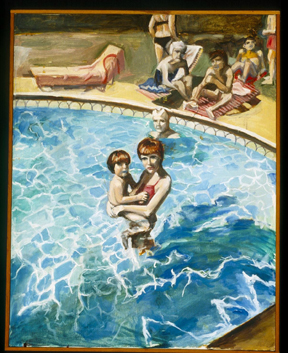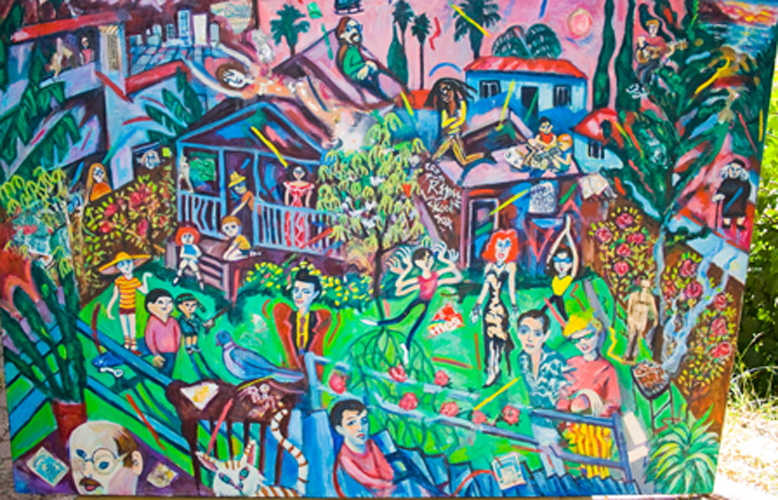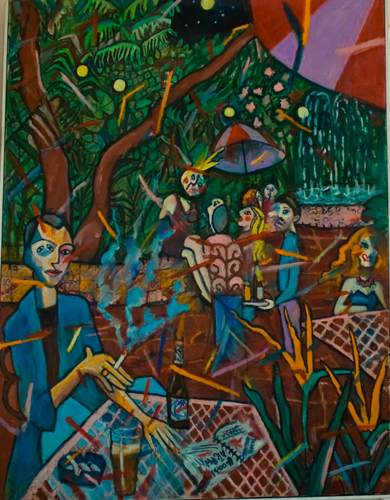VISUAL ARTIST: BARBARA ROMAIN
WORDS BY IRVIN RIVERA
Visual, performing and teaching Artist Barbara Romain opens up about being a legally blind artist, how she creatively made it work to continue painting, her documentary, and just being an artist for the sake of art. Read the full interview of this living artist and see how you can be inspired by the triumph of her stories.
PHOTOGRAPHER IRVIN RIVERA, MAKEUP ARCHANGELA CHELSEA, PHOTO ASSTS: PHIL LIMPRASERTWONG, VICTORIA INNOCENZI, FRANCIS GUM
When I learned about a living artist who is legally blind and still creating artworks, I immediate asked my then intern (now editor) to set-up an interview with Barbara.
She responded positively and welcomed our team to her house in Silverlake. It was the middle of summer in Los Angeles and Barbara openly told us stories about her life, growing up as an artist, and slowly going blind. During our interview, she also gave us a tour of her house, her room full or art, and her basement where she keeps a lot of her artworks.
Barbara Romain, STUART’S POOL | 28” x 20”, oil, 1982
Hello Barbara! Thank you for hosting us in your lovely home. Tell us more about your art and your inspiration for it?
Well this is kind of a long story. As a child I was interested in painting and drawing.
My dad was an architect and we always had drawing materials around the house. Even as a little girl I remember they saved it for many years, I made a painting when I was like 2 or 3 years old of a clown and the way I drew the eyes like tears were coming down the clown’s face. It was like this very dramatic painting.
I always loved to paint and draw. I studied it in highschool and I got a scholarship for it to go to college for painting.
When I was 6 years old I got the measles and that rendered me legally blind.
And I got this wonder drug called cortisone (at the time) that restored my vision and allowed me to go on and do all these other things (in terms of studying art).
My paintings were very realistic. I can show you an example of an oil painting I did of myself and my son in a swimming pool.
When I moved to California I was inspired by the sunlight and by the beautiful colors and the natural beauty of the place. Also, living in Hollywood, that kind of excitement was inspiring.
So I was painting very realistically. Then in the mid 1980s I started losing my sight again.
I started having trouble reading and I went to UCLA and they told me “No it's not just because you had measles as a
Child, but because you have a retinal degenerative disease.” which means it’s getting worse.
It’s a slow progression.
I have these swiss cheese holes in my vision, in other words I see a lot. I see when I am looking here in the room. I see the window most clearly. I see what’s out there cause it’s bright. You guys are mostly in silhouette.
I tell my students in school it’s like everybody in the witness protection thing like you see on t.v., like it’s all like these dotty blurry things. But when I lean more closely to your face I can see more detail.
It changes constantly; fluctuating light, fluctuating situations. It depends how I see.
I can never really predict what or how much I’m going to see exactly. Bright light helps but sometimes too much light can be hard too.
After this, as I had been painting in a more realistic style and influenced more by what I was actually seeing , suddenly I had to change my thinking.
Barbara Romain, SPIRITS OF ROMAINE ST. GATHER FOR AN L.A. BACKYARD BARBECUE 48” x 72”, oil, 1986
This painting [pointing behind her] is a good example of becoming more abstract in my work.
I had to rely more on imagination and memory. This one it reflects more about what was around me.
I still had a lot of sight (vision) when I did this. This is called, “Spirits of Romaine Street Gather for an LA Backyard Barbecue.” I used to live on Romaine St.
Very funny, you know cause my name, right?
Right by the Cemetery and Paramount Studios is where I used to live.
I was a single mom with my young son.
This was kind of our world, all the people, the neighbors, my boyfriend who later became husband, just various characters, my son and his little friends and garbage pail kids which dates it to the 80s. I’m just putting in everything that was in world at that time.
Barbara Romain, L.A. BIMBOS/QUEENS OF THE NIGHT 48” x 72”, oil, 1985
“Art is not about money, it’s not about fame, it’s not about success; although we all want those things but that can’t be your reason to make it. You make it because you love to make it. “
MUSIC AND COLORS
I went from very realistic to kind of semi-abstraction. As my sight diminished it became harder and harder for me to actually create images of what I was seeing.
Because what I was seeing was very distorted. What I was hearing became very important for me. I started doing many paintings that had words in them.
They were kind of expressions of music that I was hearing.
I would put up a big canvas and I would listen to a song over and over again.
With the color, I would follow with a color. I would make a layer with the drum and then I would make a layer with the guitar and on top would be the lyrics usually. I call these paintings my visual music. Color was very important to me the idea of using color. Music and color have a lot of things in common.
Like there’s tone, harmony and scale and they share their own vocabulary.
But they are also very emotional, music brings out a lot of emotion when you listen to it and color has that same function. It grabs you in different ways. It not just about thinking it’s more about feeling.
My work combines that feeling element. It involves thinking elements in it too, I hope.
There is thinking behind it. Like this painting here is called “Air” and it was a part of a series of “Earth, Air, Water and
Fire.” It’s about listening and thinking. It has a lot of text and words, the signs of the zodiac and
I have a poem in it. Airy, breezy, that I make up with the alphabet.
Those ideas I like to have the freedom to create and sometimes make a mistake. And often I do make a mistake like ‘oh that’s a blue line because I didn’t see the right color.’
But I let it happen and I think it makes it interesting it kind of makes it alive.
Barbara Romain, HOLLYWOOD SUNSET
When the gradual loss of sight happened what motivated you to still pursue art?
What motivated you to continue creating Art?
When it first started happening you really questioned “Well this is over for me now, how can I keep doing this?”
I was having a difficulty creating work in the same way as I used to create it.
Because I loved doing it so much and didn’t want to give it up I guess you use your creativity to think how can still do this in a different way and use what I have or what I don’t have as part of the creative process.
So you just strategize different techniques and ways of creating that will still work. And that's why again, I moved from a more figurative kind of artwork to a more naturalistic, to to a more abstract conceptual kind of painting and still use a lot of brilliant color and incorporated more words and a lot of symbols. I use a lot of stencils that I cut out.
I have this CCTv, it’s a monitor that I can kind of put things under to see what I’m doing it’s like a magnifying camera.
In other words if I want to do a fish or something, Ill draw it in a simple symbolic way and cut it out and kind of stamp it on to the painting.
I found ways.
That’s very brilliant and amazing!
And my paints have braille labels on them so I can tell the difference between a red and blue but there might be six different kinds of reds and I can’t always tell exactly what it is.
In a way I guess it’s a blessing. You always want original work because you always want to be different.
“Art is not about money, it’s not about fame; it’s not about success; although we all want those things but that can’t be your reason to make it. You make it because you love to make it.”
How did you feel in the state of becoming blind? And how did you get out of that state?
How did you feel when it first happened?
I do remember being upset and confused. I was upset.
I couldn’t quite understand what was going on.
I’m lucky I had a very loving family that got me through it.
It took several weeks but I got through it and my eyesight improved.
But as an adult, it happened at a bad time. I had just separated with my husband and I had my son with me and I was working. It was very scary. It was very worrisome. Like how am I going to deal with this?
How did I get through?
I don’t know.
Sometimes I think when you are faced with these challenges if you’re lucky you have this core of strength to gets you through.
You just know you have to go on. I had my son and I had my own life and I wanted to continue doing the things that I love to do as much as possible.
You have to put one foot in front of the other and just keep going.
Fortunately, I retained a lot of my sight. I’m not totally blind which could have been a result of what I had. And they told me that I could eventually be completely blind.
First of all, one of the most important things that I never knew growing up is that I should protect my eyes against the sun. I always now protct my eyes against the sun. Take certain vitamins, Vitamin E, Lutine, A, etc.
It hasn’t prevented it from progressing but it has slowed it a lot.
Barbara Romain, CHRIS AT CAT & FIDDLE 48” X 36”, oil, 1984
There is a documentary about you called “Can you see me” (2011) Can you tell us a little bit more about it?
Yes, it started several years ago by Linda LD Janakos who I met through a mutual friend. She asked if I could make a documentary about me and I said yes.
She was living in Santa Monica at the time and she started filming different aspects of my life and my work. Then she moved up to Santa Cruz and it became a little more difficult.
She did come down here on a few occasions. I felt a little bit frustrated
But she did a lot and finally put it together and premiered it last year. There is a couple things I am not that crazy
about. I wish I had had a little more control. She worked hard and she did a good job. 10 years I
weighed heavier, that I hate! But there are some that are more recent and that’s better.
Barbara Romain, POOLSHARK 48” X 72”, oil, 1988
Do you have any message for any upcoming and aspiring artists out there?
I think the hardest thing for artists is to just persevere. Really if you believe in yourself and if you believe in your talent, you just have to keep going because there will be plenty of people who will say no, that you are not good, that you’re not wanted that they don’t like you. You just have to believe in yourself. And be yourself. If you just try to emulate some other person, that’s not gonna work.
You just have to project your own feelings, your own ideas and just keep working.
Art is not about money, it’s not about fame; it’s not about success; although we all want those things but that can’t be your reason to make it. You make it because you love to make it.
Barbara Romain, VIEW OF THE SIGN 84” x 60”, oil, 1987












